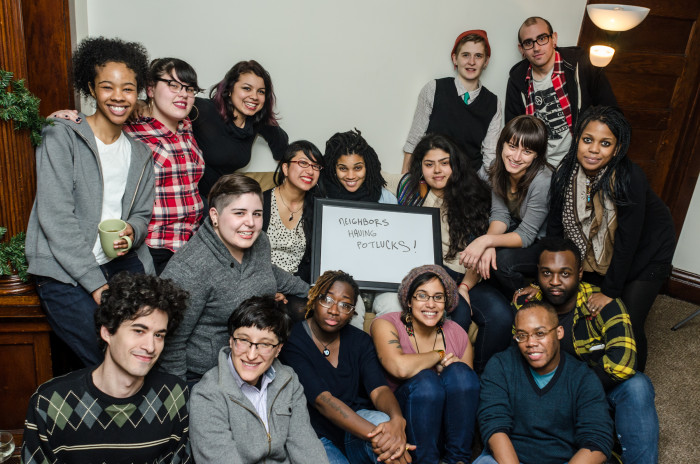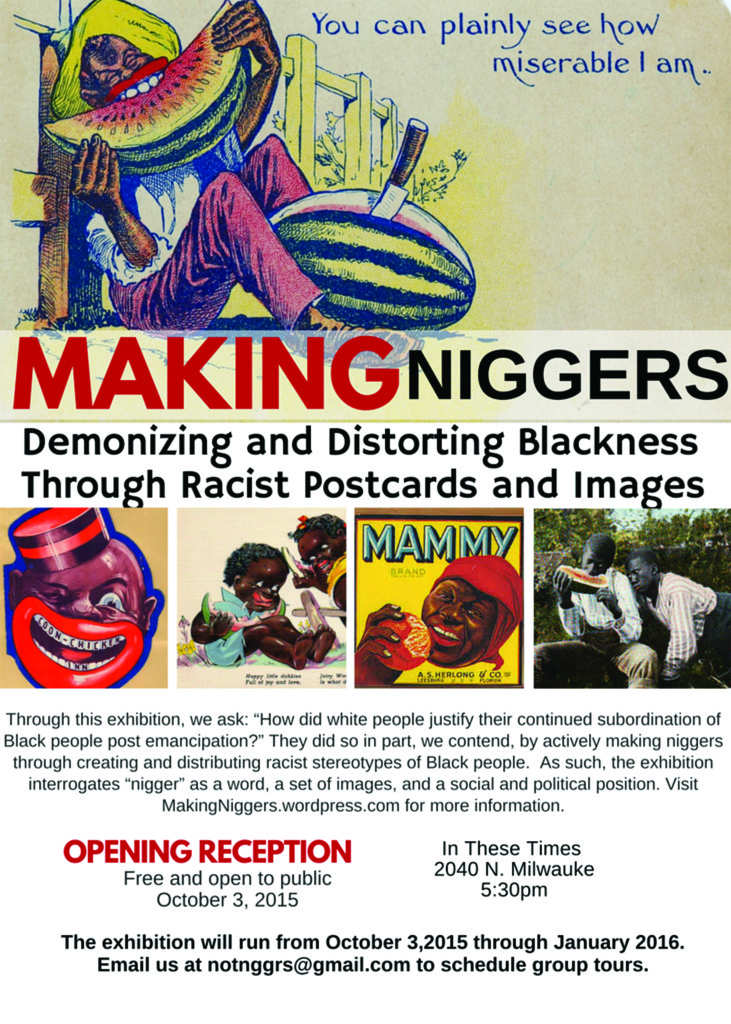There are a number of organizations and projects that I have been involved in founding. Below is a list of a few of these.
Organizations (I’ve listed just a few of the most recent ones)
We Charge Genocide (WCG): I co-founded WCG in 2014. We Charge Genocide is a grassroots, inter-generational effort to center the voices and experiences of the young people most targeted by police violence in Chicago.
Chicago Alliance to Free Marissa Alexander (CAFMA): I co-founded CAFMA in 2013. CAFMA was a volunteer-led and volunteer-run grassroots effort focused on raising money and awareness about Marissa Alexander’s case. Listen here to organizers talk about the history, legacy and work of CAFMA (now called Love and Protect).
Project NIA: I launched NIA in 2009 and am currently the Executive director of the organization. Project NIA is an advocacy, organizing, popular education, research, and capacity-building center with the long-term goal of ending youth incarceration. We believe that several simultaneous approaches are necessary in order to develop and sustain community-based alternatives to the system of policing and incarceration. Our mission is to dramatically reduce the reliance on arrest, detention, and incarceration for addressing youth crime and to instead promote the use of restorative and transformative practices, a concept that relies on community-based alternatives.
Chicago Taskforce on Violence against Young Women & Girls: I co-launched the the Chicago Taskforce on Violence Against Girls & Young Women (Taskforce) with my friend Melissa Spatz in 2009. I currently coordinate the work of the Taskforce with the support of volunteer Kristina Wallin. It serves as a vehicle for addressing the following two questions: 1. How will we galvanize attention to the devastating violence plaguing the lives of girls and young women? 2. How will we marshal the public/political will to end the violence? The Taskforce was established in order to bring groups from across Chicago together to learn from one another, share strategies and best practices, & develop new and comprehensive models of responding to violence against girls.
Chicago Freedom School: I co-founded the Chicago Freedom School in 2007 but we began the work to open in 2004. I was the board chair from 2006 through 2010 and then served on a board again from 2011 through 2013 as the Treasurer. The mission of the Chicago Freedom School (CFS) is to create new generations of critical and independent thinking young people who use their unique experiences and power to create a just world. CFS provides training and education opportunities for youth and adult allies to develop leadership skills through the lens of civic action and through the study of the history of social movements and their leaders. Our vision is in the spirit of the original freedom schools in Mississippi in the 1960s, with CFS serving as a catalyst for young people across Chicago to discover their own power to make change – not only for themselves, but also for their communities and the world.
Rogers Park Young Women’s Action Team (YWAT): I co-founded YWAT with a group of young women of color ages 13-17 in 2003. I served as the group’s primary adult ally until 2011 when we decided to close. The Rogers Park Young Women’s Action Team (YWAT) grew out of the efforts of young women who expressed concern about the rampant street violence and harassment in their neighborhood in 2003. This group of young women between the ages of 12-22 from the Rogers Park Community is committed to researching issues of violence against women and girls, raising awareness of the problem, and working to reduce its prevalence and impact. The YWAT was a youth-led, adult-supported social change project that empowers women to take action on issues that affect their lives (particularly issues of violence against girls and young women). The YWAT believes that girls and young women should be free from violence. We believe that through collective action, consciousness-raising, and organizing we can end violence against girls and young women.
Anti-Violence Projects

Community Safety Looks Like: I saw Morris Justice’s community safety wall project. I loved the idea and decided that it would be great to replicate it in Chicago. I posted a link to the project on Facebook and asked if any of my friends wanted to create our own community safety wall in Chicago. I got a terrific response and my friend, movement photographer Sarah Jane Rhee offered to help. I love this project because it opens space for us to consider the world that we’d like to see and build. It gives us an opportunity to imagine what justice might look like in our communities. In 2015, we created a publication based on this concept.

Picturing A World Without Prisons: I had the idea to invite photographers (amateur and professional) to share their ideas for how we might visualize a world without prisons. Prison abolition is a central tenet of transformative justice. I believe that using art (in this case photography) can help unlock our imaginations to think about how we might envision and build a world without prisons. This is an ongoing project that expanded to include incarcerated youth. Read about that collaboration here and here.
Restorative Posters Project (2016): “The posters, and the questions they pose, are deceptively simple. However, if we were to truly use these questions as our starting point to address crime, violence, and conflict, we would find ourselves veering far from the punitive path. To ask someone who has been harmed, “What is needed to make things right?” is to privilege healing over retribution. To ask someone who has done harm, “Who do you think has been affected by what you did?,” is to assume that learning and growth are possible.” – Paul Kuttner.
Uproar Chicago: In early 2013, as Chicagoans were bombarded with grim news about the toll of violence, I invited friends to collaborate with me on an audio collage as an outlet for the fear and frustration that many were expressing and experiencing. The result was Uproar Chicago.
History Projects and Curation
Black/Inside:In 2012, I realized a dream of mine by co-curating and co-organizing an exhibition titled “Black/Inside.” Black/Inside: A History of Captivity & Confinement in the U.S. considers how a system of criminalizing & imprisoning Black men and women has been sustained from colonial times to the present. The exhibition illustrates the historical roots of black confinement and provides insights into how the U.S. became a Prison Nation, detaining & incarcerating over 2.3 million people. While we are focused on black confinement and captivity in this exhibition, we must also necessarily interrogate what it means to be “free.” Watch the video below for more details about the exhibition:
No Selves to Defend: In 2014, I co-curated ‘No Selves to Defend.’ The exhibition features the stories of women of color who have been criminalized for self-defense. The exhibition examines the contested meanings and historical and contemporary understandings of self-defense. It seeks to locate Marissa Alexander’s story within a broader historical context and legacy. The exhibition also addresses the campaigns and mobilizations that emerged to resist their criminalization and demand their freedom. Finally, it considers how we can support current survivors of violence who have been criminalized for self-defense. The exhibition includes original art by Micah Bazant, Molly Crabapple, Billy Dee, Bianca Diaz, Rachel Galindo, Lex Non Scripta, Caitlin Seidler, and Ariel Springfield. It also includes ephemera and artifacts from Mariame Kaba’s collection.
Blood at the Root – Unearthing the Stories of State Violence Against Black Women and Girls: In 2015, I co-curated ‘Blood at the Root.’ This exhibition focuses our attention on the fact that #BlackWomensLivesMatter. Relying on various artifacts, the exhibition curators will narrate the experiences and resistance of Black women who have been brutalized, imprisoned and killed by the state and its agents. The following video by Gretchen Hasse documents the exhibition:
Lifting As They Climbed: This guidebook, written by me and Essence McDowell, features a number of Black women who contributed to the development of Chicago from the mid-19th century to today. It tells a story of Black women activists, educators and artists who lived and worked on Chicago’s South Side by taking readers on a tour of relevant landmarks and locations.
An Inside Look at Lifting As They Climbed! from Sensitive Visuals on Vimeo.
Making Niggers: Demonizing and Distorting Blackness: In 2015, I co-curated this exhibition. From the 1890’s through the 1950’s, thousands of postcards depicting racist caricatures and stereotypes of Black people were produced across the United States and the world. Degrading images of blackness also found expression in advertising and other media. Black people were portrayed as lazy, child-like, unintelligent, ugly, chicken stealing, watermelon eating, promiscuous, crap-shooting, savage and criminal. These images comforted white people in their racist beliefs, reinforced white supremacy and enabled whites to justify violence and subjugation of Black people. The stereotypes continue to shape and shorten Black lives in the present.
Relying primarily on postcards from co-curator Mariame Kaba’s collection, this exhibition speaks to the legacy of anti-Black racism that still structures our present. Our exhibition will introduce a new generation to postcards as historical documents and cultural artifacts for understanding anti-Black racism in the past and present. Dozens of postcards will tell stories of how Black people were devalued over time. These artifacts illustrate how little Black lives have mattered in this country and why we need hashtags and movements like #BlackLivesMatter today.
Through this exhibition, we ask: “How did white people justify their continued subordination of Black people post emancipation?” They did so in part, we contend, by actively making niggers through creating and distributing racist stereotypes of Black people. As such, the exhibition interrogates “nigger” as a word, a set of images, and social and political position. We expect to generate passionate discussion and debate.
Teach-ins
I co-created these sites to offer an opportunity for the public to learn more about specific people and projects.
Assata Teach-In: On Thursday May 2, 2013, the FBI announced that it was increasing its bounty for the capture of Assata Shakur (born JoAnne Deborah Byron) from 1 million to 2 million dollars. The agency also included Assata on the FBI’s Most Wanted Terrorist list, the first time that a woman had ever appeared on the list. I was motivated to call for a week of teach-ins about Assata’s life in response. With the help of my friends Dara Cooper & Shonettia Monique, I created the teach in site.
Black Radical Women in the U.S. 1910-1960 – A Study & Discussion Circle: This study and discussion circle took place on March 21, 2015 and focused on the contributions of Black radical women activists and theorists from the early 20th century through the Cold War era. Most of these women were affiliated with the U.S. Communist Party (CPUSA) and others were part of various socialist organizations.This circle will consider the backgrounds, thinking and writing of some of these leaders. We will specifically discuss the lives and contributions of Marvel Cooke, Shirley Graham Du Bois, Vicki Garvin, Esther Cooper Jackson, Claudia Jones, Queen Mother Audley Moore and Louise Thompson Patterson. This list does not begin to scratch the surface of radical Black women in the U.S. who have contributed to social, economic, political and cultural analysis and to organizing.
Teach Burge: Teaching About Police Torture: Between 1972 and 1991, Chicago Police Department (CPD) officers tortured at least 112 African American men and youth. Victims were as young as 13 years old, and at least 26 officers were involved. CPD Detective Jon Burge, the leader of CPD’s Area 2 midnight shift on the South Side of Chicago, appears to have been primarily responsible for introducing the torture techniques, which included electric shock, suffocation, burns, many kinds of beatings, use of cattle prods, use of nooses, mock executions with guns, and genital pain. Burge likely learned the electric shock tactic during his service as a military police sergeant in a Prisoner of War camp during the Vietnam War. The practical goal of the torture was often to produce confessions from suspects that could be used to convict them or others of crimes under the purview of Area 2’s investigatory responsibilities, raising Area 2’s arrest and conviction rates and assisting Burge’s rapid rise through the CPD ranks. The torture was systemic and rooted in deeply held racist beliefs. In fact, Burge and his men referred to the apparently homemade electrical device that they used to shock men with as the “nigger box.” The torture became an “open secret” among both the CPD and the city’s political establishment.
Teach Troy Davis: As Troy Davis was nearing his execution date in 2011, my friend Alice Kim emailed a group of people (including me) about putting together an “emergency curriculum” to help educators teach about Troy Davis and his case. I volunteered to create a blog for this purpose.

